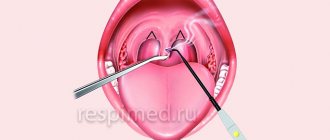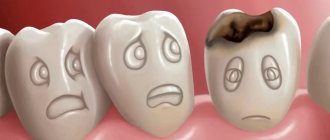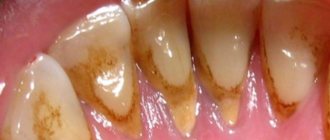Chronic tonsillitis is an inflammatory lesion of the palatine tonsils, which either subsides or worsens.
Author:
- Galkin Alexey Vladimirovich
ENT pathology expert
3.75 (Votes: 4)
Chronic tonsillitis is an inflammatory lesion of the palatine tonsils, which either subsides or worsens.
Palatine tonsils - a focus of inflammation in chronic tonsillitis
In the upper respiratory tract of a person there are a number of formations representing an accumulation of lymphoid tissue, the so-called lymphoepithelial organs - tonsils. There is a whole lymphopharyngeal ring consisting of 7 tonsils. These are unpaired pharyngeal (adenoids), lingual, laryngeal tonsils, and paired palatine and tubal tonsils. Like any organ in our body, the tonsils can be subject to inflammatory diseases.
Acute inflammation of the tonsils is a sore throat. Chronic tonsillitis refers to a long-term inflammatory process in the palatine tonsils. In most cases, tonsillitis is an exacerbation of chronic tonsillitis. The palatine tonsils (tonsils) are essentially the same mucous membrane only folded into an accordion; they are dotted inside with passages - crypts, which open on the pharyngeal surface of the palatine tonsils with lacunae.
Due to the anatomical features and location of the palatine tonsils, which are located at the crossroads of the digestive and respiratory systems, they are most often, of all other lymphoepithelial formations, susceptible to the inflammatory process, which consists of degenerative processes, as a result of which, in chronic tonsillitis, the palatine tonsils are a constant source of infection and the cause of endointoxication.
Why do we get chronic tonsillitis?
The main causes of the development of chronic tonsillitis are inflammation of the tonsils and ongoing tonsil reactions, which can be caused by long-term exposure to an infectious factor.
In the photo - lymphopharyngeal ring
During the development of chronic tonsillitis, the overall level of the body’s immunity is of no small importance.
Types of chronic tonsillitis
There are several classifications of chronic tonsillitis. The issue of classification of chronic tonsillitis is closely related to the clinical manifestations of this disease. The most widely used classification is that there are only two forms: compensated and decompensated.
- The compensated form is characterized by a course without complications, rare sore throats, often the only complaint can be only plugs in the throat, the protective role of the tonsils works by holding back harmful bacteria, and their further penetration, due to this, no special manifestations of the disease are observed.
- Decompensated form This form of chronic tonsillitis is characterized by frequent sore throats at least once a year, the occurrence of local complications, such as peritonsillar abscess, and diseases of other organs and systems of the body, such as glomerulonephritis, rheumatism.
Symptoms of chronic tonsillitis
The main manifestation of chronic tonsillitis is tonsillitis; as a rule, all patients suffering from this disease at least once have had tonsillitis. Sore throat is a fairly serious disease that affects all systems of the body and carries the risk of a number of serious complications, so the choice of treatment tactics for chronic tonsillitis should be related to the frequency of tonsillitis. The main symptoms of the disease can be identified:
| Smell from the mouth | One of the most common symptoms disturbing the patient is bad breath. This symptom is due to the fact that the area of the epithelium of the palatine tonsil is quite large; during inflammation, pathological secretions accumulate in the crypts of the tonsils in the form of caseous (curdled) masses. Caseous masses are evacuated through the lacunae into the pharyngeal cavity, causing bad breath. |
| Sore throat, ear | One of the main symptoms of chronic tonsillitis is pain in the throat, often a feeling of a lump in the throat. Also, the symptoms of chronic tonsillitis can be expressed by headache, unpleasant sensations in the ear, mild pain in it, which is caused by irritation of the nerve endings in the parenchyma of the palatine tonsil and irradiation of pain along the nerve fiber to the ear. |
| Enlarged lymph nodes | You can often observe an enlargement of the lymph nodes located under the jaw, and the cervical lymph nodes also enlarge. When palpating the lymph nodes, mild pain occurs. |
Quite a large number of patients do not immediately detect the symptoms of chronic tonsillitis and delay contacting an ENT doctor, which often leads to decompensation of the disease and longer treatment in the future.
Caseous plugs - remains on the battlefield
Tonsils, or tonsils as they are popularly called, are an organ that protects the body from harmful bacteria.
The palatine tonsils are covered with special depressions (lacunae), in which the immune system kills microbes that enter the mouth along with air and food. After the fight, “corpses” of microbes, leukocytes, and food residues remain on the battlefield. But the tonsils of a healthy person are quickly cleared of debris and continue to perform their function. And caseous plugs (tonsillitis) appear when the tonsils are inflamed. Their composition is almost identical to pus, so they cause concern for patients. In fact, the deposits themselves are not dangerous, but they signal the presence of an infection in the oral cavity.
The most common causes of traffic jams are untreated tonsillitis and chronic tonsillitis (inflammation of the tonsils). In addition, deposits can be caused by the following factors:
- chronic runny nose;
- sinusitis;
- adenoids;
- untreated caries;
- smoking;
- hypothermia;
- low immunity.
The disease often occurs in young people under 30 years of age. Sometimes tonsillitis may not make itself felt at all, but in some cases it causes bad breath and interferes with eating.
In addition, as orthodontists note, chronic otolaryngological diseases can cause malocclusion.
Moreover, since everything in the body is interconnected, the situation can turn in the opposite direction. In particular, if care is not taken to straighten teeth in cases of serious anomalies, ENT diseases may also follow.
Therefore, if you are faced with a problem such as caseous plugs, it would not be superfluous to make an appointment with an orthodontist. Your doctor will likely prescribe short-term treatment for your malocclusion with Invisalign aligners.
Such an integrated approach will eliminate the problem on both sides once and for all.
How to identify chronic tonsillitis
Diagnosis of chronic tonsillitis does not present any particular difficulties for an experienced otolaryngologist. The patient's medical history and complaints are of utmost importance in diagnosis; as a rule, the history includes previous sore throats and complaints of frequent pain and discomfort in the throat.
Examination of the throat for chronic tonsillitis
During mesopharyngoscopy (examination of the pharynx) for chronic tonsillitis, the following signs are present: hyperemia and roller-like thickening of the edges of the palatine arches; cicatricial adhesions between the tonsils and palatine arches; loosened or scarred and hardened tonsils; caseous-purulent plugs or liquid pus in the lacunae of the tonsils.
What methods of hardware washing of tonsils are there?
Washing the tonsils is a procedure that is performed only by an ENT doctor. This can be done in several ways:
- Using a special syringe. During the procedure, the doctor uses a syringe with a curved metal tube attached to it. It is introduced into the lacuna. This breaks the traffic jams. The syringe contains a solution of an antiseptic - furacillin, potassium permanganate and others. Liquid is pumped into the lacuna. It pours out, squeezing out pus. Vacuum washing method. Removal of purulent plugs occurs under the influence of ultrasound. Radiation promotes the penetration of drugs into deep lacunar passages. This type of washing can produce almost complete cleansing of lacunae. Cavitation method combined with ultrasound. When ultraacoustic vibrations pass through a liquid, cavities with air are formed in it. When they collapse, a shock wave is formed. It damages the cell membranes of bacteria.
Using these techniques, together with drug therapy, it is possible to achieve a significant reduction in exacerbations of chronic tonsillitis.
Complications of chronic tonsillitis
Chronic tonsillitis has serious complications; they are divided into two groups: local and general. All complications, as a rule, occur during an exacerbation of the process occurring in the form of a sore throat and represent the consequences of untimely treatment of chronic tonsillitis.
With chronic tonsillitis, in the upper respiratory tract of a person, more precisely in the palatine tonsils, there is a focus of chronic inflammation; the problem of focal infection is very acute in modern medicine. Currently, there are about fifty different metatonsillar diseases, which are the result of chronic inflammation in the palatine tonsils. Let's take a closer look at what this can most often threaten.
Peritonsillar abscess
This is the most common local complication. The fact is that between the palatine tonsil and the muscles of the pharynx to which it is attached there is fiber, the so-called paratonsillar fiber. With severe inflammation, the infection can enter this tissue through the hematogenous route, causing its infiltration and purulent melting, and an abscess is formed. Peritonsillar abscess is a very serious disease that requires immediate surgical treatment, usually in a hospital setting, since there is a threat of the purulent process spreading through the cellular spaces of the neck into the mediastinum, which can be fatal.
Diseases of the heart, joints and kidneys
An important role in the inflammatory process in chronic tonsillitis is played by group A beta-hemolytic streptococcus, which often parasitizes the palatine tonsils. The fact is that immune complexes that form in the body as a response to the aggression of this antigen can also attack healthy tissue in the joints, heart and kidneys, which, if not treated in a timely manner, can even lead to disability.
Weakness and decreased ability to work
The parenchyma of the palatine tonsils is densely penetrated by blood and lymphatic vessels, and in the thickness of the organ there are many nerve endings that connect to important autonomic centers. In chronic tonsillitis, inflammatory products enter the circulatory and lymphatic systems, and constant endotoxification occurs. All these factors plus pathological impulses from irritated nerve endings lead to decreased tone, bad mood, and apathy.
Regular colds
With chronic tonsillitis, the body spends a lot of effort to contain inflammation in the tonsils, the immune system is under constant stress, which leads to its significant weakening. Added to this is the not always correct work-rest regime, nutrition, and environmental conditions, as a result of which a person with chronic tonsillitis may literally not “get out” of a cold.
Inflammatory diseases of the respiratory system
The palatine tonsils are anatomically located in the pharynx, close to such organs as the trachea, larynx, and paranasal sinuses. With chronic tonsillitis, microbial contamination of the entire area of the respiratory mucosa occurs, which contributes to the development of diseases such as sinusitis, bronchitis, and laryngitis.
Stomach and intestinal problems
The palatine tonsils are located at the crossroads of the digestive and respiratory systems. Due to certain anatomical features, they represent a rather large conglomerate of the mucous membrane. In chronic tonsillitis, this entire area of the mucosa is involved in the inflammatory process and secretes a pathological secretion in the form of a liquid fraction and caseous masses. This pathological content is evacuated into the pharynx through lacunae and then swallowed with saliva, which often causes disturbances in the functioning of the gastrointestinal tract.
Surgical treatment of chronic tonsillitis
The whole variety of methods for treating chronic tonsillitis is divided into two large groups: surgical methods and conservative ones. Let us dwell in detail on surgical treatment. A radical surgical method is tonsillectomy - removal of the organ along with the capsule should not be confused with tonsillotomy, which is often done in childhood.
Video: tonsillectomy - removal of tonsils
With tonsillotomy, unlike tonsillectomy, not the entire organ is removed, but only a fragment of the hypertrophied parenchyma of the pharyngeal surface of the tonsil. It is necessary to resort to tonsillectomy in extreme cases; for this there must be compelling indications, such as a complicated advanced form of the disease, despite the fact that all possible methods of conservative treatment have been exhausted. Despite these “canons” that have been established for many years, removal of tonsils is often resorted to due to the lack of availability of conservative treatment, and sometimes due to the banal lack of a competent specialist dealing with this issue.
The function of the palatine tonsils is extremely important - it is an element of the pharynx, after the removal of these organs, areas of the pharynx that were covered by these formations begin to be subject to irritation by air and food masses, is this good or bad? Apparently this is bad, since nature, as a result of a long process of evolution, did not give us a single extra organ.
Preparation of an ozonized solution for a session of deep vacuum ultrasonic sanitation of the palatine tonsils
Often, tonsils are removed from patients who have not even had a history of sore throat, and whose only complaint was caseous plugs in the throat and bad breath. The long-term result of operations to remove palatine tonsils is often severe sore throat and the development of atrophic pharyngitis, which is difficult to treat.
Conservative methods of treating chronic tonsillitis include various methods of washing the tonsils. Comprehensive information about this manipulation is presented in the article washing the tonsils.
Treatment of tonsils
Previously, a common practice for tonsillitis (tonsillitis) was to prescribe tonsil removal, now new methods of treating tonsils have appeared and doctors prefer to use conservative therapy and only prescribe surgery if it is ineffective. The choice of methods for treating tonsillitis depends on the type of disease. Chronic tonsillitis is of two types:
- compensated. Characterized by the manifestation of external signs of inflammation. At the same time, the tonsils continue to perform protective functions;
- decompensated. In this case, dysfunction of the tonsils is added to the inflammation. Relapses of tonsillitis occur more than three times a year. The infection itself progresses, destroying organ tissue and causing scarring.
Compensated tonsillitis
Treatment of tonsils with compensated tonsillitis involves removing the dangerous contents of the organs and suppressing the source of inflammation. The treatment process must be carried out comprehensively: strengthen the immune system, follow the principles of a healthy diet, and take medications to relieve intoxication.
For tonsillitis, the following treatment methods are used:
- removal of pus and plugs from tonsil lacunae;
- introduction of medicinal substances into the lacunae;
- lubrication of tonsils.
In addition, treatment of tonsils usually involves undergoing a course of various types of physiotherapy (UHF, ultraviolet irradiation, ultrasound, laser). It is useful both as a treatment and as a means of preventing the disease. The course of treatment usually includes about ten sessions.
Decompensated tonsillitis
For this type of disease, the doctor usually prescribes surgical removal of the tonsils. This is a necessary measure that can be resorted to after other treatment methods have exhausted themselves.
Surgery to remove the tonsils is called a tonsillectomy. Depending on the condition of the organs, removal can be complete or partial (tonsillotomy). The procedure allows you to get rid of tonsillitis forever, as its root cause – the source of infection – is eliminated.
Treatment of chronic tonsillitis without surgery
Despite the wide market of medical services, there are not so many effective conservative methods of treating chronic tonsillitis. The fact is that in modern otorhinolaryngology it is customary to divide the mucous membrane into fragments, there are doctors who deal only with diseases of the nose - rhinologists, there are specialists who deal only with the treatment of the throat. In fact, the entire area of the mucous membrane lining the upper respiratory tract is one organ.
Session of deep vacuum ultrasonic sanitation of palatine tonsils with ozonated solution
We are forced to obtain oxygen from the air, and the air is not sterile; the respiratory organs, like no other system of our body, experience a colossal biological load and are constantly in contact with microbes. The anatomical structure of the upper respiratory tract is the product of a long period of evolution. The upper respiratory tract is a complex mechanism created by nature with one purpose: to be a protective barrier. Moreover, many ENT diseases (adenoids, vasomotor rhinitis, sinusitis, chronic pharyngitis), which are classified as different and treated in different ways, are essentially one disease in different stages of development, so to speak, a “machine” in different stages of breakdown.
Video: treatment of chronic tonsillitis
So, the essence of many inflammatory ENT diseases, including chronic tonsillitis, is a degenerative process in the mucous membrane, caused by the microbes that we breathe, as a result of the weakening of the protective properties of the mucous membrane. It follows from this that when doing treatment you need to influence the entire area of the mucous membrane of the upper respiratory tract, you just need to take into account some anatomical features - such as the structure of the palatine tonsils, and taking these features into account, locally enhance the therapeutic effect. Since the palatine tonsils are essentially the same mucous membrane only folded into an accordion, washing the tonsils should be an integral part of the treatment process.
Conducting a photodynamic therapy session on the pharynx area for chronic tonsillitis
The lack of effective methods for treating chronic tonsillitis is also due to the fact that there are a number of dogmas in modern medicine. One of them is that the most common way to fight germs today is with antibiotics. Antibiotics, unfortunately, do not penetrate well into the upper layers of the degenerative mucous membrane; moreover, they do not restore it. With chronic inflammation, the regeneration of the mucous membrane is disrupted and microerosions form on it. Figuratively speaking, the mucous membrane becomes like a “sieve,” which is the most important basis for the inflammatory process.
Stimulation of reflexogenic zones in chronic tonsillitis
Taking into account the above, the main task of treating chronic tonsillitis is to influence all parts of the pathogenesis of the disease, therefore the following methods are used in our clinic:
| Cleansing tonsils with ozonized solution | In our clinic, we wash the palatine tonsils using the tonsillor apparatus with an ozonated solution, which is by far the most effective way to cleanse the entire thickness of the tonsils from pathological contents. |
| Sanitation of mucous membranes with mineral salts | In our clinic, we irrigate the entire mucous membrane with a solution of individually selected mineral salts, which sanitize the mucous membrane and restore it, which cannot be achieved with modern antibiotics. We also activate mucosal regeneration using photodynamic therapy. Lymph stasis plays an important role in the pathogenesis of inflammation, including chronic tonsillitis. Activation of lymph flow in the area of inflammation plays an important role: this is how the “soldiers” of our immunity - lymphocytes - move along with lymph. |
| Stimulation of reflexogenic zones | With the help of injections into the reflexogenic zone of the neck, ozone causes a spasm of the subcutaneous lymphatic vessels, which activates the lymph flow in the pharynx, leading to rapid stabilization of the immune system. The integrated approach we use affects all parts of the pathogenesis of chronic tonsillitis, which allows it to be treated conservatively, avoiding surgical treatment. |
A complex approach
First stage
Viral tonsillitis - treatment with a good and pronounced effect is obtained by washing the lacunae of the palatine tonsils. There are two ways to wash the tonsils.
A very old method is to rinse the tonsils with a syringe. Previously, this method was widely used, but today it is used for lack of a better one or when the patient’s gag reflex is very pronounced.
The disadvantages of this method are that during the process of washing the palatine tonsils, the pressure created by the syringe is not sufficient to effectively wash out caseous masses from the lacunae of the tonsils. Also, this technique is contact and traumatic, since when using a straightened attic needle, its thin and sharp end can prick the inner surface of the palatine tonsil, namely the crypts - the channels into which the needle enters. Also, the tip from the set with a syringe is used for rinsing the tonsils and injecting into the larynx. On the contrary, it is very wide in diameter and injures the tonsil tissue when inserting the tip into the lacuna, or in general, due to the large outer diameter, it cannot always get there.
Practice has shown that today, the best results are achieved by the approach when the ENT uses the Tonsilor attachment.
First, it is necessary to rinse the lacunae of the palatine tonsils with a modified attachment of the Tonsilor apparatus with a transparent antiseptic solution, for example, saline solution (also known as isotonic sodium chloride solution). This is necessary so that the doctor can clearly see what he is washing out of the palatine tonsils.
Second phase.
Since the tonsils are washed from pathological secretions, it is necessary to immediately influence the tissues of the palatine tonsils with low-frequency ultrasound. At the same time, a medicinal solution passes through the ultrasonic tip of the “Tonsilor” apparatus, which, due to the ultrasonic effect of cavitation, turns into a finely dispersed medicinal suspension, which, due to hydraulic shock, hits the tissues of the palatine tonsil and the posterior wall of the pharynx with force and impregnates the medicinal solution into the submucosal layer of the tonsil.
The procedure for exposure to ultrasound is correctly called: Ultrasonic medicinal irrigation. In our clinic we use a 0.01% solution of Miramistin. This drug is good because it does not lose its properties under the influence of ultrasound. Miramistin is a very strong antiseptic drug, and ultrasound exposure further enhances the durability of the physiotherapeutic effect.
Third stage.
It is necessary to treat (lubricate) the palatine tonsils with Lugol's solution, which is also a strong antiseptic based on iodine and glycerin.
Fourth stage.
The otorhinolaryngologist at our clinic conducts a laser therapy session on the tissue of the palatine tonsils and the mucous membrane of the posterior pharyngeal wall. Laser treatment of tonsillitis in adults is very effective. Its action is aimed at reducing swelling and inflammation of the tissues of the palatine tonsils.
The laser radiation source can be installed in the oral cavity and acted in close proximity to the palatine tonsils and the mucous membrane of the posterior pharyngeal wall, thereby achieving the best results.
You can also install the laser emitter on the skin of the anterolateral surface of the neck in the projection of the location of the palatine tonsils and the posterior wall of the pharynx.
Fifth stage.
It is recommended to conduct sessions of vibroacoustic influence. They are carried out with the aim of normalizing microcirculation in the tissues of the palatine tonsils and improving the trophism (nutritional function) of the palatine tonsils themselves.
Sixth stage.
Effectively sanitize the microflora located on the surface of the palatine tonsils using ultraviolet irradiation (UVR).
This method has long been known, has proven itself very well and is still in service in many city (especially children's) clinics.
In this case, it is necessary to approach courses. The number of procedures in each specific case is determined individually at the first consultation with an ENT specialist. But for a lasting effect to occur, at least five sessions must be performed. If, during the fifth procedure, caseous and mucous masses are still washed out of the lacunae of the palatine tonsils, rinsing and other procedures must be continued “until clean rinsing waters”. As a rule, the number of ENT procedures does not exceed 10 treatment sessions.
After a full course, the lacunae of the palatine tonsils restore their ability to cleanse themselves, and the patient feels much better and more energetic.
In order to have a lasting result, it is necessary to carry out conservative treatment 2 to 4 times a year, as well as independently once every 3 months, take homeopathic and antiseptic medications.
In this case, you will most likely be able to avoid exacerbations of this disease and the need to remove the tonsils.
If, 2-4 weeks after the end of the course, caseous detritus again begins to accumulate in the thickness of the palatine tonsils, and the patient’s ENT complaints begin to bother them, as before the start of the course, conservative treatment of chronic tonsillitis in children and adults is considered ineffective. In this case, the patient is asked to consider the option of surgical removal of the tonsils. But fortunately, such an outcome (result) is quite rare.









